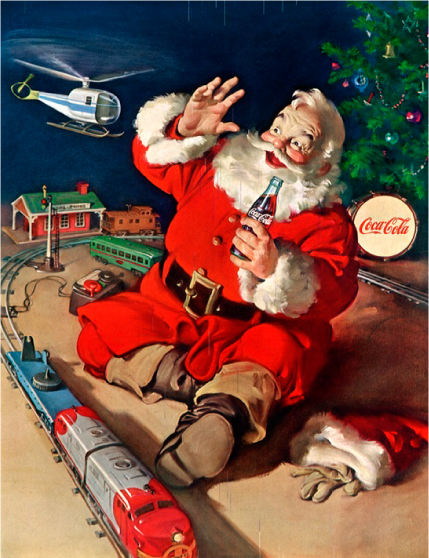by Glenn R. Swift

He’s known by many different names in many different languages: Santa Clause (a.k.a. Claus), Father Christmas and Saint Nick just to name a few. Some believe in him, some do not. For those who do, he comes every Christmas. For those who don’t, he hasn’t shown up yet! But there’s one thing we can all agree on, he has a long history, and it all begins with Saint Nicholas.
Saint Nicholas
Most experts in religious folklore believe that there is no hard evidence to support that St. Nicholas ever existed as a human. In fact, there are quite a few indicators that the legend of St. Nick is based on ancient Pagan tales centuries before the founding of Christianity. This should not be too much of a surprise since many other ancient Pagan gods and goddesses were similarly Christianized in the early centuries of the Church.
 Santa’s legends appear to have been mainly created out of myths attributed to the Greek God Poseidon, the Roman God Neptune, and the Teutonic God Hold Nickar. During the Middle Ages, the Christian church created a fictional life history for St. Nicholas, the earliest on record was Hagios Nikolaos (Greek for St. Nicholas of Myra).
Santa’s legends appear to have been mainly created out of myths attributed to the Greek God Poseidon, the Roman God Neptune, and the Teutonic God Hold Nickar. During the Middle Ages, the Christian church created a fictional life history for St. Nicholas, the earliest on record was Hagios Nikolaos (Greek for St. Nicholas of Myra).
As you can well imagine, numerous legends and miracles are attributed to Saint Nicholas. When he was an infant, his mother was said to have nursed him only on Wednesdays and Fridays; he fasted the remaining days. (Now that’s willpower for a baby!) Throughout his life, he is reputed to having adored children, often throwing gifts (anonymously that is) into the windows of their homes. One fable recounts a sailor who fell overboard and was reputedly saved by Nicholas when the saint walked on water, retrieved the sailor and carried him back to the ship. (I’ve heard something similar before.)
Then we have the story of an innkeeper who had robbed and dismembered some students. Well… Nicholas faithfully re-assembled them and restored them to life! Now that’s a talent! Another story has Nicholas taking pity on an impoverished family with three daughters who faced the threat of being forced into prostitution because they had no wedding dowries. For two of the daughters, the ever-resourceful (and apparently wealthy) St. Nick crept up to their house at night and threw bags of gold through a bedroom window. For the last daughter, he threw a bag of gold down the chimney — which landed in a stocking that she had set by the fireplace for drying. Get it now? So, the traditional association of chimneys and stockings with Santa Clause comes from this story. Last, but not least, Nicholas was also noted for rewarding children (good ones that is) with treats if they had studied their catechism and behaved well. This is how St. Nicholas became the patron saint of schoolchildren and sailors.
 Santa Clause
Santa Clause
The metamorphosis of Saint Nicholas to Santa Clause has taken place primarily in America but with inspiration from the Dutch. In the early days of the New Amsterdam colony, the Dutch Sinterklass became known among their English-speaking neighbors as “Santa Clause” (or “Saint Nick”). In 1809, Washington Irving, a member of the New York Historical Society (which promoted a Dutch Saint Nicholas as its patron saint), created a tale of a chubby, pipe-smoking little Saint Nicholas who rode a magic horse through the air visiting all the houses in New York. The elfish figure was small enough to slide down chimneys with gifts for the good children and switches for the bad ones.
So, you could say that today’s Santa Clause is the sum total of several trends, customs and beliefs that only became unified about a century and a half ago. His story is retold every Christmas as a loose-knit collection of tales attributed to the three given to him in America: St. Nicholas, Kriss Kringle and Santa Clause.
Clement Clark Moore
Much of the present form of the Santa story is most certainly due to the works of two New Yorkers, Dr. Clement Clark Moore and Thomas Nast, the latter is often acclaimed as the “Father of the American Cartoon.” In 1822, Dr. Moore wrote a Christmas poem, A Visit from St. Nicholas to read to his children on Christmas Eve. The following year, Harriet Butler read the poem and requested a copy from him. Later, she sent it without Moore’s consent for publishing to the Troy, New York Sentinel. Although in Santa’s vernacular that might have been “naughty,” the poem became immensely popular across the United States. As for the apparent plagiarism, in 1938 Moore revealed that St. Nicholas was his creation. It has appeared countless times since.
 Thomas Nast
Thomas Nast
The 19th century American cartoonist Thomas Nast, who amazingly had lived on the same West 23rd Street as Dr. Moore, did a series of Christmas drawings for Harper’s Weekly. The Harper’s story was where today’s much familiar fat and rosy cheeked Santa with his large beard and ringing bell made his debut. (This came after a series of modifications of the little elf-like creature depicted in Dr. Moore’s poem.)
Of course, no story about Santa would be complete without another colorful New York vignette. You see, little more than a century ago, eight-year old Virginia O’ Hanlon wrote a letter to the editor of the New York Sun enquiring as to if there really was a Santa Clause. The editor replied, “Yes, Virginia, there is a Santa Clause.”
Santa has been real for millions of children ever since.
